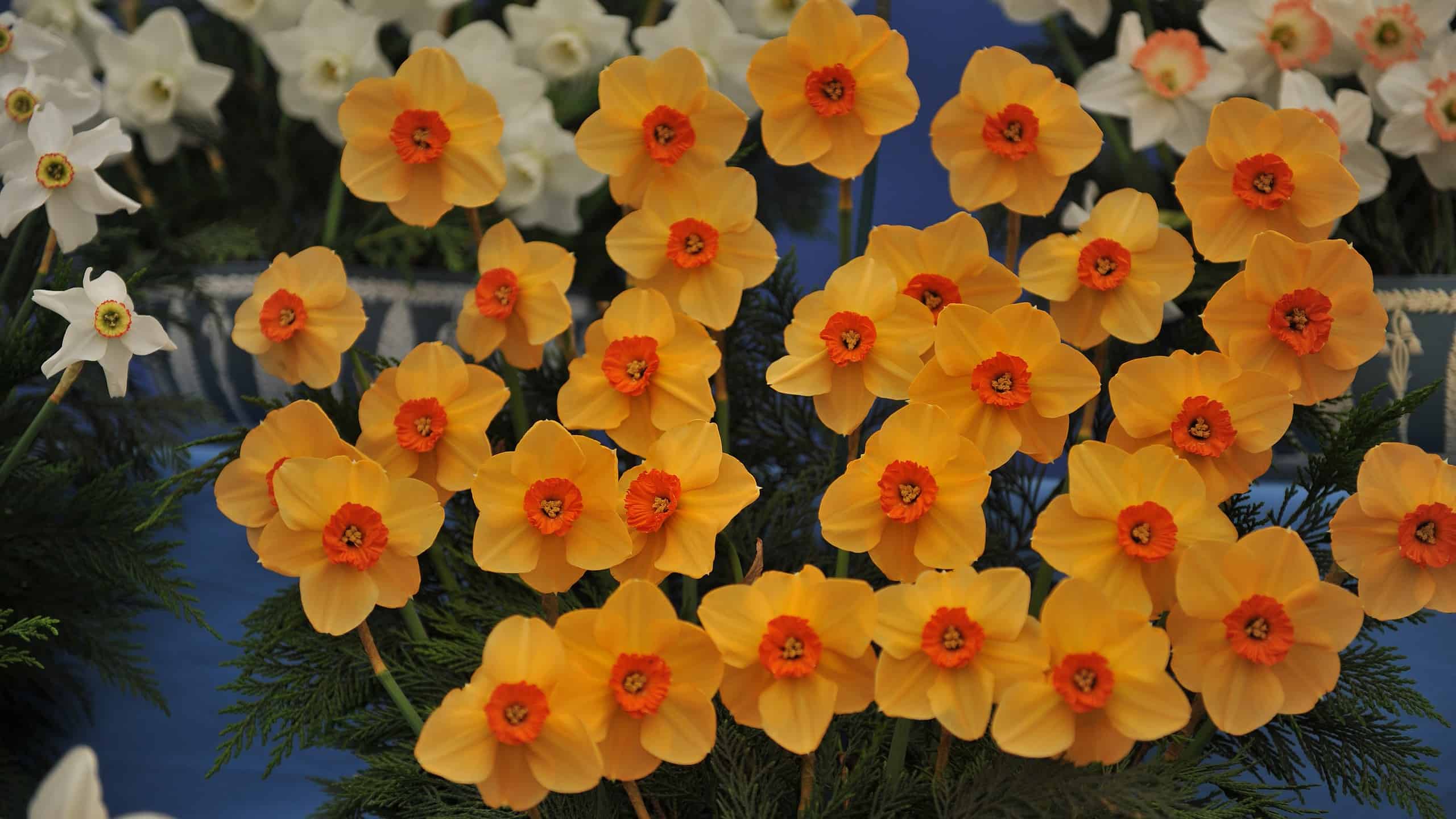Daffodils are a welcome sight in spring, and they survive through harsh winters as a bulb buried safely in the soil. They’re commonly planted in gardens across the world because they are hardy and striking. What are 7 beautiful colors of daffodils to spruce up your yard? We’ll look at the color combinations available and describe some corresponding varieties that produce these colors.
1. White Daffodils

Mount Hood daffodils start with a bit of yellow in their corona, but they fade to all white.
©Alex Manders/Shutterstock.com
White daffodils may seem plain in passing but they’re a vital addition to a garden landscape as they’re more elegant than some of the flashier varieties. They also provide a visual break between color types if you’re planting multiple varieties in the same garden bed.
Mount Hood daffodils are a white variety commonly seen in pots because they’re easy to force into bloom. Forcing the blooms of daffodils is a technique used indoors during seasons that don’t usually support flowering plants.
The Mount Hood, Cassata, and Jenny daffodils are examples of the transition that some white daffodils go through as they age. When they first bloom, their corona is pale yellow. As these flowers age throughout the season, they lose their yellow coloration and become uniformly white.
The Thalia variety is white from start to finish. It is also very fragrant so it brings the smells of spring to your landscaping.
| Name of Daffodil | Daffodil Division | Single or Bunching | Time of Blooms | Rarity | Hardiness Zone |
|---|---|---|---|---|---|
| Cassata | 11 | Single | Early Spring | Common | 3 to 7 |
| Ice Wings | 5 | Bunching | Mid-Spring | Common | 4 to 9 |
| Jenny | 6 | Bunching | Early and Mid-Spring | Very Rare | 3 to 9 |
| Misty Glen | 2 | Single | Late Spring | Uncommon | 3 to 7 |
| Mount Hood | 1 | Single | Mid-Spring | Common | 3 to 9 |
| Thalia | 5 | Bunching | Mid-Spring | Common | 3 to 9 |
2. White and Yellow Daffodils
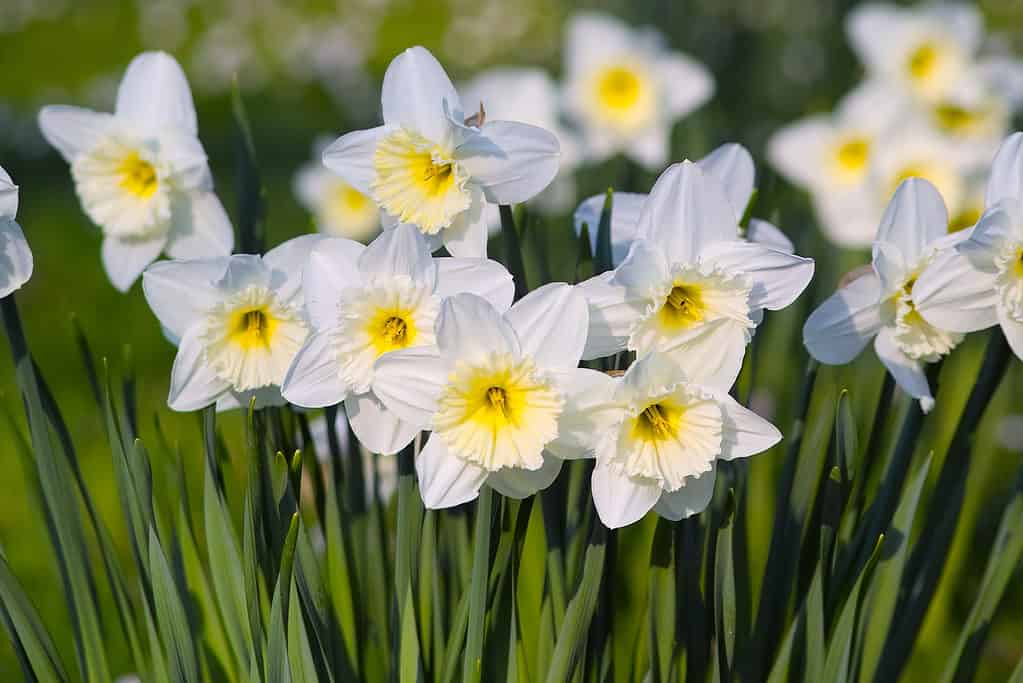
Ice Follies are white and yellow daffodils commonly seen in homes as they’re easily forced into bloom.
©Ole Schoener/Shutterstock.com
Like some of the varieties on the pure white daffodil list, some of the white and yellow varieties lighten to an almost uniformly white coloration by the end of the blooming season. Ice Follies and Las Vegas varieties are often seen inside homes because forced blooming of their bulbs comes easily.
| Name of Daffodil | Daffodil Division | Single or Bunching | Time of Blooms | Rarity | Hardiness Zone |
|---|---|---|---|---|---|
| Ice Follies | 2 | Single | Early to Mid-Spring | Common | 3 to 9 |
| Ice King | 4 | Bunching | Mid-Spring | Uncommon | 3 to 9 |
| Sovereign | 11 | Single | Late Spring | Rare | 4 to 8 |
| Lapwing | 5 | Bunching | Early to Late Spring | Rare | 4 to 8 |
| Golden Echo | 7 | Bunching | Mid-Spring | Common | 5 to 9 |
| Crewenna | 1 | Single | Late Winter to Early Spring | Rare | 3 to 8 |
| Toto | 12 | Bunching | Early Spring | Rare | 4 to 11 |
| Goblet | 1 | Single | Early to Mid-Spring | Common | 3 to 8 |
| Las Vegas | 1 | Single | Early to Mid-Spring | Very Common | 3 to 8 |
| Jack Snipe | 6 | Single | Mid-Spring | Uncommon | 3 to 9 |
3. White and Pink Daffodils
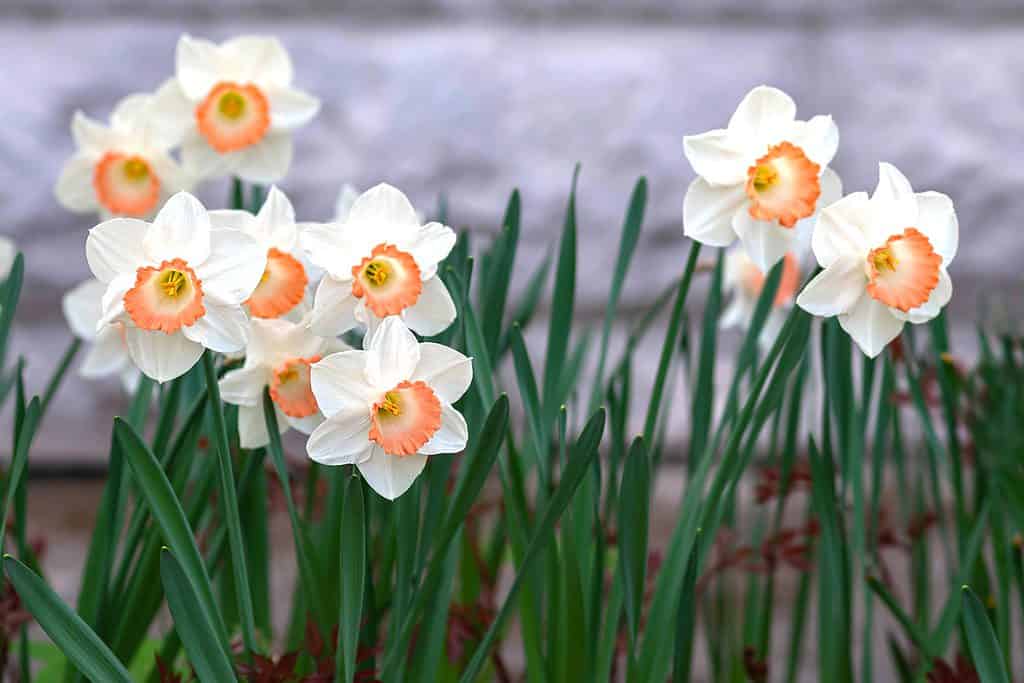
White and pink daffodils have coronas that are salmon or peach in color.
©berdimm/Shutterstock.com
There are no truly pink daffodils. Instead, daffodils that are described as pink have a peach or salmon corona.
In warmer weather, these daffodils come out more pink. On the flip side, a colder spring will make the flowers lean more toward orange.
Pink daffodil varieties need to be planted in partial shade or their color will quickly fade. However, the Accent variety stays pink when planted in places with constant sunlight.
| Name of Daffodil | Daffodil Division | Single or Bunching | Time of Blooms | Rarity | Hardiness Zone |
|---|---|---|---|---|---|
| Accent | 2 | Single | Mid-Spring | Common | 3 to 8 |
| Bell Song | 7 | Bunching | Mid to Late Spring | Common | 5 to 9 |
| Pink Charm | 2 | Single | Early to Mid-Spring | Uncommon | 3 to 8 |
| Precocious | 2 | Single | Mid to Late Spring | Common | 3 to 7 |
| British Gamble | 1 | Single | Early to Mid-Spring | Common | 3 to 8 |
| Cha Cha | 6 | Single | Early Spring | Uncommon | 3 to 8 |
4. White and Orange Daffodils

Orange and white daffodils are hybrids like most multi-colored daffodils.
©Jackie Tweddle/Shutterstock.com
White and orange daffodils are hybrids like most of the other multi-colored daffodils in this article. This means that seeds produced by these flowers will not necessarily produce blooms that look like their parents. However, naturalizing bulbs will look like the original flower.
This phenomenon occurs because seeds are a result of sexual reproduction. Sexual reproduction pulls genetic information from both flowers involved in propagation. Bulbs that spread on their own reproduce asexually which means that their genetics do not change.
| Name of Daffodil | Daffodil Division | Single or Bunching | Time of Blooms | Rarity | Hardiness Zone |
|---|---|---|---|---|---|
| Redhill | 2 | Single | Late Winter to Mid-Spring | Rare | 3 to 8 |
| Virginia Sunrise | 2 | Single | Mid-Spring | Uncommon | 3 to 8 |
5. White, Orange, and Yellow Daffodils

Barrett Browning daffodils do well under deciduous trees.
©Balazovic Lubos/Shutterstock.com
White, orange, and yellow daffodils come in various shapes and sizes. However, one thing most have in common is that they have white petals with yellow coronas that have orange-stained edges.
The Barrett Browning variety takes well to force blooming. This type of daffodil does well in areas under deciduous trees. Since they bloom early in the spring, a deciduous tree will not have leaves that will shade them too much.
| Name of Daffodil | Daffodil Division | Single or Bunching | Time of Blooms | Rarity | Hardiness Zone |
|---|---|---|---|---|---|
| Flower Record | 2 | Single | Mid-Spring | Rare | 3 to 8 |
| Zinzi | 11 | Single | Mid-Spring | Uncommon | 3 to 8 |
| Barrett Browning | 3 | Single | Early Spring | Uncommon | 3 to 8 |
| Merlin | 3 | Single | Early to Mid-Spring | Uncommon | 3 to 9 |
6. Yellow Daffodils
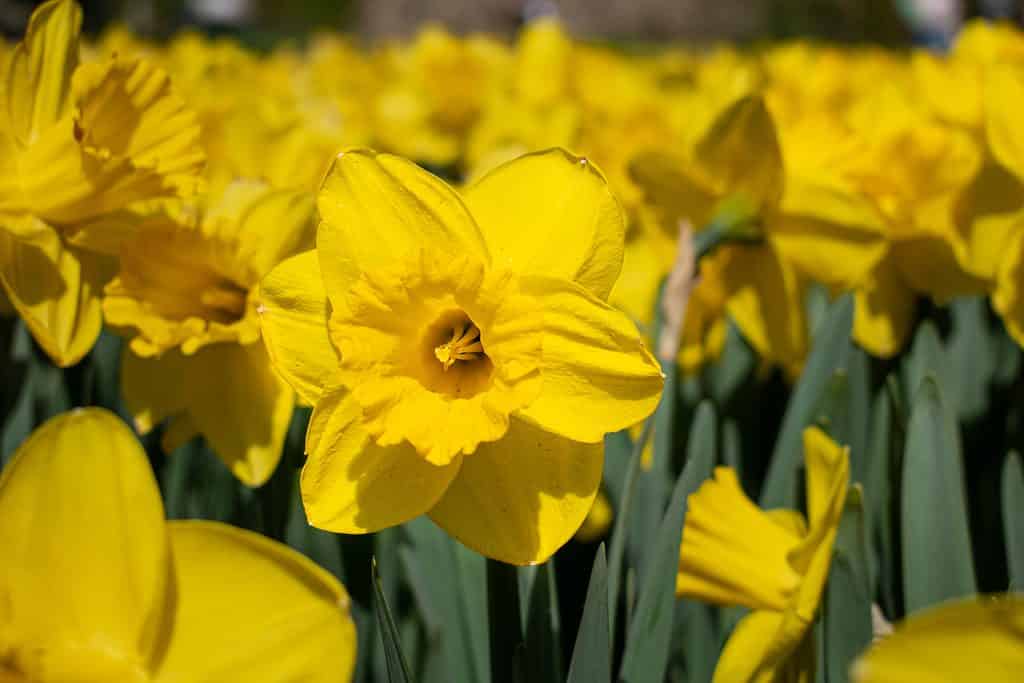
Dutch Master daffodils are the most popular daffodil variety.
©Dajbog Nicoleta/Shutterstock.com
Yellow daffodils are the normative star of the daffodil world. When most people think of these flowers, yellow daffodils are what come to mind. Specifically, the Dutch Master is the most popular daffodil on the market.
There are many shades and sizes of yellow daffodils, and many of the most commonly seen yellow varieties are found growing wild. Despite this, there are yellow daffodils specifically bred for gardens.
The Dutch Master is a large variety that is commonly potted indoors as it takes well to forced blooming. Small yellow daffodils commonly seen growing indoors are the Tete a Tete as they are also easy to force into bloom.
| Name of Daffodil | Daffodil Division | Single or Bunching | Time of Blooms | Rarity | Hardiness Zone |
|---|---|---|---|---|---|
| Tete a Tete | 12 | Bunching | Early Spring | Common | 3 to 8 |
| Dutch Master | 1 | Single | Early to Mid-Spring | Very Common | 3 to 9 |
| Rapture | 6 | Single | Early Spring | Common | 3 to 8 |
| Quail | 7 | Bunching | Mid-Spring | Uncommon | 4 to 9 |
| February Gold | 6 | Single | Late Winter to Early Spring | Uncommon | 3 to 9 |
7. Yellow and Orange Daffodils
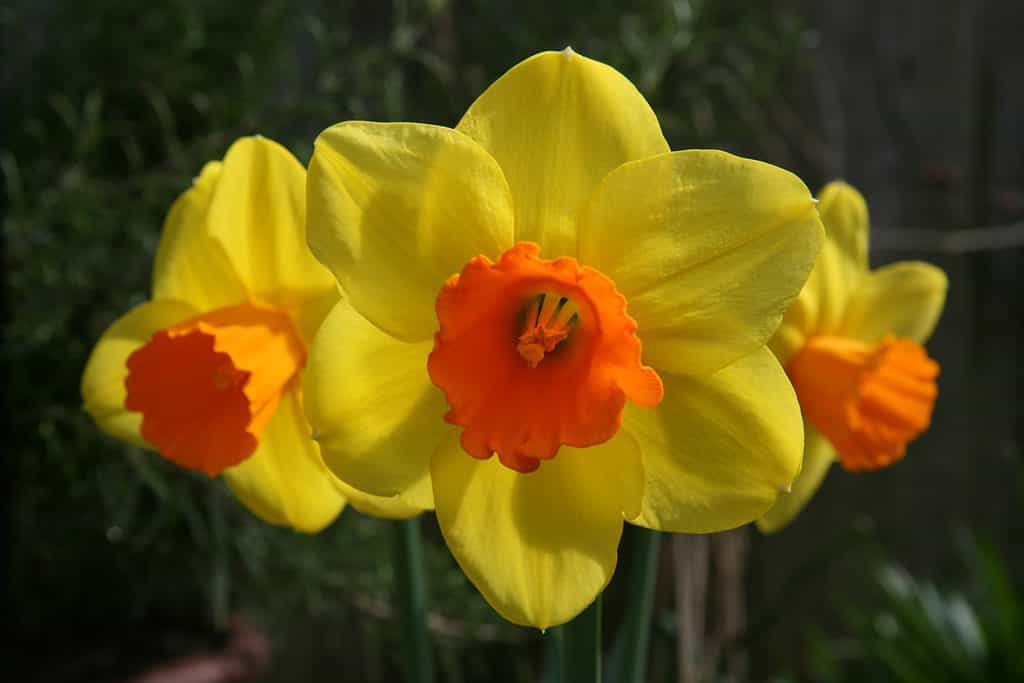
Orange and yellow daffodils are popular vibrant varieties found in gardens.
©Wirestock Creators/Shutterstock.com
Yellow and orange daffodils are a popular favorite that are seen in the wild and as cultivars in flower beds. Some of these daffodils are simple in that their petals are yellow and their coronas are solid orange. Others are vibrant and pastel at different points throughout the flower.
While a true red color in daffodils hasn’t been invented yet, some of the flowers on this list have such a deep orange quality that they might be misconstrued for red. An example of a reddish flower is the Red Devon which looks like the tip of its orange corona was dipped in red ink.
| Name of Daffodil | Daffodil Division | Single or Bunching | Time of Blooms | Rarity | Hardiness Zone |
|---|---|---|---|---|---|
| Berlin | 2 | Single | Mid-Spring | Rare | 3 to 8 |
| Fortissimo | 2 | Single | Mid-Spring | Common | 3 to 8 |
| Ferris Wheel | 2 | Single | Early to Mid-Spring | Uncommon | 3 to 9 |
| Red Devon | 2 | Single | Mid-Spring | Common | 3 to 8 |
| Jetfire | 6 | Single | Early to Mid-Spring | Common | 3 to 9 |
| Orange Progress | 2 | Single | Mid-Spring | Common | 3 to 8 |
Thank you for reading! Have some feedback for us? Contact the AZ Animals editorial team.

